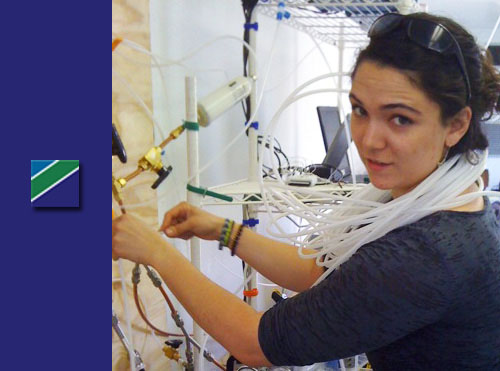
Student Focus: Amber Ortega
Of the thousands of different organic particles floating through the air, researchers have only identified 10 to 30 percent of them, and the atmospheric roles of many remain unknown. Amber Ortega, a graduate student with CIRES Fellow Jose-Luis Jimenez’ group, is working to change that. During fall 2009, at the U.S. Forest Service Rocky Mountain Research Station’s Fire Sciences Laboratory in Missoula, Mont., she investigated the types of organic aerosols (airborne carbon-based particulates) that result during fires.
When forests, grass and other vegetation burn, the smoke carries different aerosols and gases into the air. Some of these gases then react with sunlight—a process called photochemical processing—or other airborne compounds to form additional aerosol species. Aerosols can harm human health (aggravating allergies, asthma and cardiovascular problems), lower visibility and affect climate.
While at the laboratory, in a 3,000m3 room, Ortega and her team set ablaze 16 types of fuel, such as ponderosa pine, saw and wheat grass, turkey oak and black spruce. Using a potential aerosol mass (PAM) oxidation reactor, she exposed smoke to ultraviolet light to simulate the sun’s effects—but at a much faster rate. The device can replicate two weeks of atmospheric aging in about five minutes. An aerosol mass spectrometer then analyzed what organic aerosols were produced between zero to two weeks of effective aging. They discovered that different fuels, such as grasses,
generate more organic aerosols after aging than ponderosa pine. “So where a fire breaks out and what species burn greatly affect how much aerosol ends up downwind,” Ortega said.
CIRES offers graduate student fellowships.
![]() about CIRES fellowships at
cires.colorado.edu/education.
about CIRES fellowships at
cires.colorado.edu/education.


